Clearjel® is a modified corn starch.
It is made by the Ingredion company (formerly the National Starch and Chemical Company) of Bridgewater, New Jersey.
There are two types of Clearjel: the regular, which is the type that is used in home canning and which this page focusses on, and an instant version, which might be of use in some DIY mixes for home, but is another topic altogether.
Clearjel is a proprietary name. It seems to be spelled in a zillion different ways by people. Note the correct spelling of Clearjel®: with a “j”, and all one word.
Technical specs and datasheets for Clearjel (on company site)
- 1 Clearjel’s role in home canning
- 2 Instant vs canning Clearjel
- 3 Clearjel really only thickens upon cooling
- 4 Clearjel performance
- 5 Cutting back on the amount of Clearjel a recipe calls for
- 6 Where to buy Clearjel
- 7 Clearjel Measurements
- 8 The history of the Clearjel recommendations
- 9 No additional usage recommendations for Clearjel from the USDA / NCHFP
- 10 Clearjel alternatives
- 11 Alternative Replacement Modified Starches for Clearjel
- 12 What are private sector partners doing with Clearjel?
- 13 Clearjel in Jams
- 14 Clearjel in pressure canning
- 15 What is the correct spelling of Clearjel?
- 16 Nutritional Information about Clearjel
- 17 Clearjel GMO, Kosher, Halal etc status
- 18 Further Reading
Clearjel’s role in home canning
Clearjel® has been accepted by the USDA and the National Center for Home Food Preservation for a single canning application as of 2015, which is for use as a thickener in some fruit pie fillings. Beyond that, it has also been accepted for a few additional tested canning applications by some University Extensions, as well as by the Rubbermaid company in the United States and Canada, owner of Ball and Bernardin.
PermaFlo®, ThermFlo® and Thick Gel® are commercial equivalents that have been accepted equally along with Clearjel by some University Extensions.
Instant vs canning Clearjel
Note this page applies to regular (aka “cook type”) Clearjel® and not the instant version; the instant version is not suitable for canning use. Instant Clearjel is meant for thickening things that won’t be cooked. It begins to thicken the minute it hits a liquid, without any heat being required. It can be heated once, but don’t use it for anything that will be heated twice. (That makes the instant unsuitable for home-canned fillings, but it would be okay for pie fillings that will be frozen instead of being canned.) Its properties may make it of interest in some DIY mixes as well.
Clearjel really only thickens upon cooling
One of the concerns in home canning about most thickeners is that because the thickener thickens as soon as heat starts to hit the food product being canned, density issues may be encountered causing insufficient heat penetration for complete processing of the jar and therefore an unsafe product.
Clearjel (and its equivalents) differ from other thickeners in that they only thicken a small amount when heat first hits them; the real thickening starts only as the food item starts to cool.
[Clearjel] works well in preparing canned pie filling because the sauce remains thin during processing to allow heat to penetrate the jar completely and safely. The filling thickens in the jar after jars are removed from the canner. It is the only thickener recommended by the USDA for use in home canning” [1] Penn State Extension. Modified Food Starches. October 2012. Accessed January 2015 at https://extension.psu.edu/food/preservation/news/2012/modified-food-starches
“All these products show their maximum thickness (viscosity) upon cooling.” [2] Penn State Extension. Modified Food Starches. October 2012. Accessed January 2015 at https://extension.psu.edu/food/preservation/news/2012/modified-food-starches
In home canning terms, this means possibly in theory that because Clearjel (and its equivalents) might hold the promise of not interfering with heat penetration during the heating phase, it may eventually find application in other home canned products such as syrups or soups. But there are no lab-tested, certified-safe recipes for such applications as of 2015.
Clearjel® is a corn starch that has been modified to give it special and unique characteristics when used in food products. It can be used for canned fruit pie fillings because it does not break down in the acid food mixtures and does not thicken enough during heat processing to interfere with the intended effect of the heat on killing bacteria during canning. It is preferred for thickening canned pie fillings as well as other foods over other corn starches because it has less or no aftertaste, the thickened juices are smooth and clear, and foods thickened with Clearjel® may be frozen.” [3] Andress, Elizabeth L. Purchasing and Using Clearjel. University of Georgia cooperative Extension. FDNS-E-116. July 20015. Accessed March 2005 at https://spock.fcs.uga.edu/ext/pubs/fdns/FDNS-E-116.pdf
Clearjel performance
While from the safety point of view the concern is about when the thickening happens, from a quality point of view there’s also the performance question: does the thickener go lumpy in the heat of canning? From a cook’s point of view, is it desirable as an actual thickener?
There are several advantages in using Clear Jel rather than other thickeners in canning. It does not break down and become thin when used in home-canned pie fillings. In addition, the sauce remains thin during processing allowing heat to penetrate the jar completely. This complete heat penetration insures the product’s safety. The filling thickens in the jar after jars come out of the canner. The shelf-life of Clear Jel in canned foods is excellent. Canned products retain a smooth texture with no liquid separation or curdling. [4] Oregon State Extension Clear Jel Recipes. Accessed May 2015 at https://www.nicholsgardennursery.com/store/avactis-images/u/ClearJelNEW.pdf
Clearjel does not go lumpy: “…it does not break down in the acid food mixtures …. has less or no aftertaste, the thickened juices are smooth and clear…” [5] Andress, Elizabeth L. Purchasing and Using Clearjel. University of Georgia cooperative Extension. FDNS-E-116. July 20015. Accessed March 2005 at https://spock.fcs.uga.edu/ext/pubs/fdns/FDNS-E-116.pdf
Clearjel does not break down over multiple heatings as some other thickeners would. In fact, in home-canned pie fillings, it easily survives three heatings:
“…it will not break down as the pie filling is cooked in preparation for canning, heated during the canning process, and heated a third time as the pie is baked…” [6] Ingham, Barb. Oozing canned pie filling. Blog posting. University of Wisconsin Extension. 23 October 2017. Accessed October 2017 at https://fyi.extension.wisc.edu/safepreserving/2017/10/23/safe-preserving-oozing-canned-pie-filling/
Some people don’t like Clearjel; they report that they feel Clearjel changes the flavour of the filling, and, that it sets overly hard. Others feel that instead of hard, it creates a “gelatinous goo/icky texture.” [7] GardenWeb discussion forum. Accessed March 2015 at https://forums.gardenweb.com/discussions/1934500/flour-is-no-no-what-for-mustard-pickles#6902878
Still others say that canning your fruit plain with no thickener whatsoever makes a jar of it more versatile; that should you choose to use a jar of fruit for pie, it’s easy enough to sprinkle some starch ( be it corn starch, flour, tapioca) over it in a pie shell as you would for fresh anyway.
Cutting back on the amount of Clearjel a recipe calls for
Some people say that when Clearjel is used in the quantities the USDA calls for, it makes the mixture more like a jelly than a pie filling. “As to what many of us don’t like about canning with Clear Jel – when used in the amounts called for in some recipes it is often TOO thick, almost jelled. So many of us cut the amount called for. If you will pull up the many discussions here about using Clear Jel you’ll find for example that with pie fillings some reduce it by ½ or more.” [8] User digdirt2 on Gardenweb forum. Comment made 27 August 2012. Accessed May 2015.
Cutting back on the amount of Clearjel would not affect the safety of the recipe, as you are reducing the thickener and lowering the density, which does not impact negatively the tested heat penetration.
Barb Ingham, USDA Extension Agent at Wisconsin says she personally cuts back on the amount of Clearjel:
Extension recommends the use of Clear Jel, a modified corn starch, for thickening pie fillings for canning. In my experience the end result is too thick; I like to use only 75% of the amount of Clear Jel listed in the recipe for a thick, but not too thick product.” [9] Ingham, Barb. Safe Preserving: Apples, the best of the fall harvest. Blog posting. University of Wisconsin Extension. 7 October 2015. Accessed 2015 at https://fyi.uwex.edu/safepreserving/2015/10/07/safe-preserving-apples-the-best-of-the-fall-harvest
She further writes,
“Use ¾ of the amount of Clearjel recommended in Extension recipes. …. . Experimentation has shown that using ¾ of the amount of Clearjel stated in the recipe will produce a very acceptable filling, but one that is a little less thick and therefore less likely to ooze from the jars. So, if the recipe calls for 1-½ cups of Clearjel, use only ¾ of this amount or 1 Cup plus 2 Tablespoons, and so forth.”[10] Ingham, Barb. Oozing canned pie filling. Blog posting. University of Wisconsin Extension. 23 October 2017. Accessed October 2017 at https://fyi.extension.wisc.edu/safepreserving/2017/10/23/safe-preserving-oozing-canned-pie-filling/
Where to buy Clearjel
Clearjel is very hard to source still even as of 2015 for consumers, even though it is broadly used commercially by the tons, and if you are not in North America, your chances of getting it are sadly probably slim to none.
If you are wondering why some official canning recommendations were based on a relatively obscure, hard to find ingredient, this quote may explain why: “The marketing plans being discussed for Clearjel® at the time home-canned pie filling recipes were developed have never materialized. Unfortunately, Clearjel® is available only through a few supply outlets and is not currently available in traditional grocery stores.” [11] Andress, Elizabeth L. Purchasing and Using Clearjel. University of Georgia cooperative Extension. FDNS-E-116. July 2005. Accessed March 2015 at https://spock.fcs.uga.edu/ext/pubs/fdns/FDNS-E-116.pdf That statement was made in 2005, and the situation hasn’t changed 10 years later, in 2015. Clearly, the USDA people had expected broader distribution of the Clearjel product at a consumer level, and were let down.
When you are shopping for it, you may be more likely to find it in bakery-supply stores than bulk or health-food stores. These stores have to buy it in large 50 lb (22.7 kg) commercial quantities, and then break it down into small bags, usually of 1 pound or ½ kg, for consumers.
Expect to pay anywhere from 4 to 8 dollars per pound / 500g. On average, a l pound / 500 g bag will do one batch of 7 large jars of pie filling.
See here for Canadian sources of Clearjel.
Here’s a sample link for an Amazon seller of it but do shop around as prices vary dramatically for what is the same product.
Clearjel Measurements
500 g (1 pound) of Clearjel will do 7 litres (7 US quarts) of pie filling. Allow one litre (one US quart) jar of pie filling per 20 to 23 cm pie (8-inch or 9-inch pie.) [12] Food Safety & Preservation: Fruit Pie Fillings. OREGON STATE UNIVERSITY Extension Service. SP 50-616, Revised February 2013. Accessed March 2015 at https://extension.oregonstate.edu/fch/sites/default/files/documents/sp_50_616_fruitpiefillings.pdf
- There are about 3 cups in 1 pound of Clearjel;
- There about 3 ¼ cups in ½ kg of Clearjel.
The history of the Clearjel recommendations
The very first okay (“recommendation”, in USDA terms) for using Clearjel in an approved canning recipe happened in 1988. It was for use in a canned apple pie filling; the recommendation was based on research that had been done earlier in the 1980s by Kuhn et al. at the Pennsylvania State Center of Excellence. [13] Andress, Elizabeth. “History, Science and Current Practice in Home Food Preservation.” Webinar. 27 February 2013. Accessed January 2015 at https://nchfp.uga.edu/multimedia/video/nchfp.wmv
In the 1994 USDA guide, the use of Clearjel as a pie filling thickener was continued with apple, and extended to blueberry, cherry, and peach pie fillings [14] United States Department of Agriculture (USDA). Complete guide to home canning. Agriculture information bulletin No. 539. 1994. Page 2-14 to 2-19
The 2009 and 2015 USDA Complete Guides continued those recommendations but held the line there. [15]United States Department of Agriculture (USDA). Complete guide to home canning. Agriculture information bulletin No. 539. 1994. Page 2-26 to 2-30
No additional usage recommendations for Clearjel from the USDA / NCHFP
As of 2013 (and indeed spring 2015), the USDA and the National Center for Home Food Preservation stand by the Clearjel recommendation for those four pie fillings, but have not broadened that recommendation for any other usage: “I have access to no data or have ever been aware of any home canning recommendations being developed by Extensions or the USDA that use Clearjel in anything but the pie fillings. So I could not recommend adding that to any of our other tomato products; it’s a thickening agent, it would be expected to slow down the heat penetration and the process times we have would not therefore be adequate. In other words, don’t try to make a gravy with Clearjel or flour and can it like a beef broth or a chicken broth because it’s going to heat much more slowly and those times would not be expected to sterilize in the same manner.” [16] Andress, Elizabeth. “History, Science and Current Practice in Home Food Preservation.” Webinar. 27 February 2013. 1:33:30 Accessed January 2015 at https://nchfp.uga.edu/multimedia/video/nchfp.wmv
So there is no approval from the center — the USDA / NCHFP — for use of the modified starch called Clearjel in anything other than those four pie fillings.
Many people are experimenting using Clearjel in many different canning recipes. But the officials still say, “Starch products, modified or regular, should not be added to home canned products unless it is called for in a scientifically tested recipe, and then it should only be used in the amount specified.” [17] Penn State Extension. Modified Food Starches. October 2012. Accessed January 2015 at https://extension.psu.edu/food/preservation/news/2012/modified-food-starches
That being said, given that the Clearjel makers didn’t follow through on making the product available at a consumer level, it would seem apparent that neither the USDA or NCHFP would have any great incentive to develop more uses for a product their audience can’t get hold of.
Note: Oregon State Extension as of 2013 allows for the use of Clearjel in Apple, Blackberry, Blueberry, Cherry and Peach canned pie fillings [18] Food Safety & Preservation: Fruit Pie Fillings. OREGON STATE UNIVERSITY Extension Service. SP 50-616, Revised February 2013. Accessed March 2015 at https://extension.oregonstate.edu/fch/sites/default/files/documents/sp_50_616_fruitpiefillings.pdf So they’ve added one pie filling — blackberry. They did it by allowing the USDA cherry recipe to accept blackberry as a substitute.
Clearjel alternatives
The National Center for Home Food Preservation says that in the USDA pie filling recipes, you must use Clearjel and can make no substitute.
There is no substitution for Clearjel® that can be made in these recipes. This means do not use other corn starch, flour, tapioca, or other thickener in our recipes.” [19] Andress, Elizabeth L. Purchasing and Using Clearjel. University of Georgia cooperative Extension. FDNS-E-116. July 20015. Accessed March 2005 at https://spock.fcs.uga.edu/ext/pubs/fdns/FDNS-E-116.pdf
This is likely because those recipes have only been tested for safety and quality with Clearjel, and they can’t support variances or recommendations that they haven’t lab tested themselves.
Alternative Replacement Modified Starches for Clearjel
Thermflo
Pennsylvania State Extension is the entity which made the original Clearjel recommendation. They have since accepted ThermFlo as an alternative, and even seem to prefer Thermflo for its performance in the after-canning phase: “ThermFlo is an acceptable alternative to use in canned pie fillings because it is also stable during heating and exhibits about the same viscosity during heating as regular Clearjel. It also has the added advantage of holding up well during storage.” [20] Modified Food Starches. Penn State Extension. Blog Posting October 2012. Accessed March 2015 at https://extension.psu.edu/food/preservation/news/2012/modified-food-starches
It is made by Ingredion, the same company that makes Clearjel, but may not be any easier to find than Clearjel as it only appears to be sold in very large quantities.
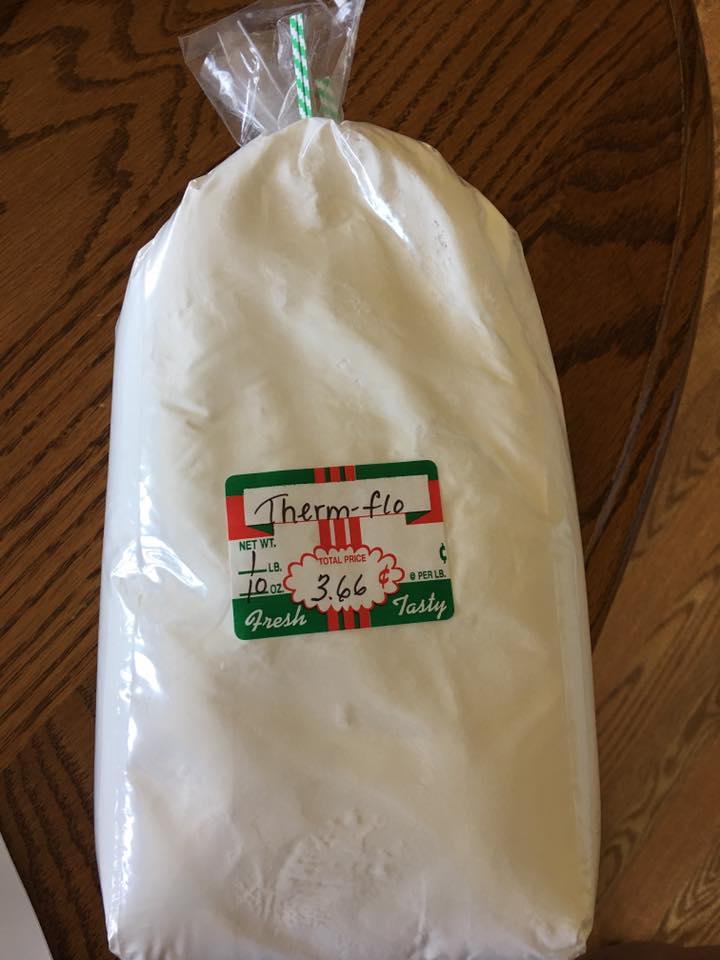
Thermflo. Photo courtesy of Ronda R. Heding-Pedley, 2017.
Thick Gel
Utah State Extension recognizes Thick Gel as an alternative for Clearjel. Thick Gel advertises itself as gluten-free, and non-GMO.
Thick Gel is made and marketed by Cornaby’s, a Utah company, so the Utah State Extension would have likely had good access to the product and manufacturers for testing and consultation.
The company, Cornaby’s, does sell directly to consumers, so the product may be easier to get at. Here’s the link for Thick Gel product and ordering information (link valid as of January 2021.)
Note: If you see people saying that “E-Z Gel” (formerly named Ultra Gel; name changed in November 2017) is recommended by Utah State for canning, what they likely mean is the “Thick Gel.” Just as Thick Gel is meant to be an equivalent to Clearjel, a sister product, “E-Z Gel”, is meant to be an equivalent to Instant Clearjel. Thick Gel is the one you would want for canning, as the measurements and behaviour would appear to be equivalent. (That being said, according to Cornaby’s if you are using their Thick Gel, you can actually cut back on the thickener a bit. They say, “1 Tablespoon Clearjel=¾ Tablespoon Thick Gel.”)
Minnesota stands firm — no to anything but Clearjel
Note that Minnesota Extension doesn’t want any of their audience to deviate from Clearjel:
( Q) I’ve used Clearjel® as a thickener for home-canned pie fillings. Can I also use PermaFlo® and ThermFlo® for home-canned pie fillings?
( A ) PermaFlo® and ThermFlo® are other forms of modified starches and are available for commercial use. Because there is no available research on the use of these products for home food preservation, we recommend you continue to use Clearjel® which has been tested for adequate heat penetration in the water-bath canner and provides excellent pie filling quality.” [21] Home Food Preservation Newsletter. University of Minnesota Extension. September 2011. Accessed March 2015 at https://www.extension.umn.edu/food/food-safety/home-food-preservation-newsletter/docs/home-preservation-sept-2011.pdf . Page 4.
What are private sector partners doing with Clearjel?
It’s important to remember that universities and governments aren’t the only ones equipped with testing labs and trained professionals. The Newell (formerly Jarden) companies (Ball in the US and Bernardin in Canada) also have their own labs and professionals to develop tested, safe, quality recipes.
Here’s what they are doing with Clearjel as a thickener:
Ball Blue Book
As of 2015, there is still not a single recipe in the Ball Blue Book where Clearjel is drawn on. Instead, Ball continues to rely heavily on refined sugars and refined syrups such as corn syrup as thickeners.
Ball / Bernardin Complete Book
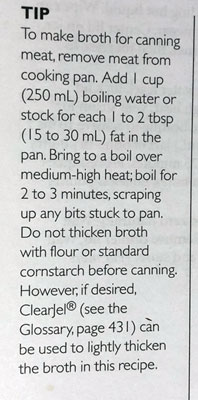
Clearjel in canning meat
The Ball / Bernardin Complete Book (2015) has a “Homestyle Corn Relish” recipe calling for 2 tablespoons of Clearjel as a thickener. Other recipes calling for Clearjel include Golden Relish, Fennel Relish, Mustard Pickles, Marrow and Onion Mustard Pickles, Mustard Beans, and a small handful of pie fillings.
The Ball / Bernardin Complete Book (2015, page 397) allows the canning broth for cubes or strips of meat to be slightly thickened with Clearjel. “If desired, ClearJel can be used to lightly thicken the broth in this recipe.” [22]Kingry, Judi and Lauren Devine. Ball / Bernardin Complete Book of Home Preserving. Toronto: Robert Rose. 2015. Page 397. They do not state what “lightly” means.
Ball Online
On their web site, Ball extended the range of pie fillings using Clearjel by providing a recipe for Raspberry Pie Filling thickened with Clearjel (recipe lost by them in a web site rearrange in 2020.)
Bernardin Guide to Home Preserving, 2013 edition
Bernardin calls for Clearjel in a few pie fillings (Blueberry, Cherry and Raspberry Pie fillings, page 40), but branches out beyond that to use it for two relishes as well. In the relishes, it possibly replaces what might have been the now politically-incorrect flour in the old days.
- Homestyle corn relish, page 76. (2 tablespoons Clearjel)
- Grandma’s Golden Relish, page 78. (5 tablespoons Clearjel)
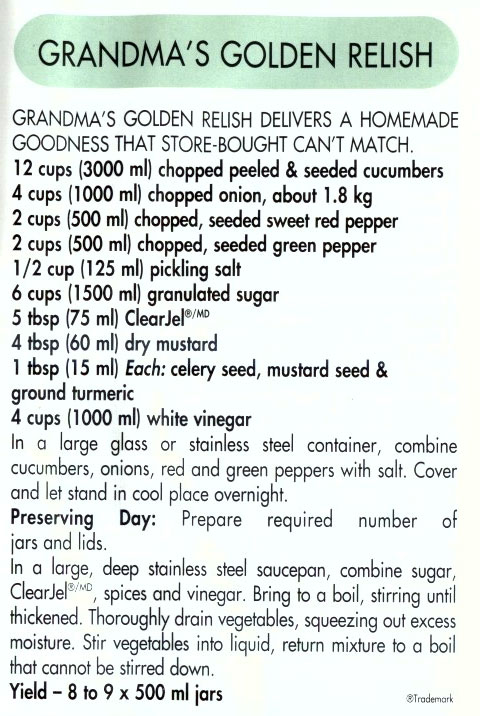
Grandma’s Golden Relish. Recipe cited to illustrate the use of Clearjel in a savoury preserve. From: Bernardin Guide to Home Preserving. Toronto, Canada: Bernardin Ltd. 2013. Page 78
Clearjel in Jams
Here are Washington State University Extension’s recipes for home canned jams made using Clearjel.
Here is a Blueberry Jam with Clearjel we made using one of their recipes.
Some people are starting to experiment making sugar-free jams using Clearjel. [23] See: Shipp, Cindy. Master Food Preserver and SB Canning author. Making Jam with Clearjel. Accessed March 2015 at https://www.sbcanning.com/2014/08/making-jam-with-clear-jel.html
As seen from their “preservingfoodathome.com” blog, the National Center for Home Food Preservation is curious about this in principle, and certainly not immediately opposed to the concept per se, though they can’t come out and endorse it:
Modified corn starch (like Clearjel) does not depend on the same concentration of sugar to form a gel, if any added sugar at all with some fruits, so it makes sense to use in low-to-no sugar recipes. Since the spread would not have sugar to aid in its preservation, it may require a slightly longer than usual process time for long-term room temperature storage. These products could very well be thickened fruit purees and will not fit the definition of a pectin jam or jelly, even though it produces a spreadable, gel-like consistency. However, we do not know of tested recipes using Clearjel for making canned low-to-no-sugar jams and jellies, and have not developed any ourselves, so we are unable to make specific recommendations for its use at this time.” [24] National Center for Home Food Preservation. Comment on topic of “Want to Make Sweet Spreads, but Don’t Want to Add Sugar?”. Preserving Food at Home Blog. 11 August 2014. Accessed March 2015 at https://preservingfoodathome.com/2014/08/01/want-to-make-sweet-spreads-but-dont-want-to-add-sugar/comment-page-1/#comment-6796
The NCHFP may be under two constraints :
- They are under the constraint of only being able to endorse what they or the USDA have actually clinically tested and documented; and
- They work under woefully inadequate federal funding to let them investigate even a minute fraction of the things the public is asking them to. [Feel free to let your elected reps know you’d like a bit more money invested in them.]
The University of Nebraska Extension people, though, are not prepared to even ponder the use of Clearjel in preserves. They start, and end, the discussion with: “Clearjel is not recommended for jams or jellies….” [25] Albrecht, Julie A. Let’s Preserve: Jams, Jellies, and Preserves. University of Nebraska Lincoln Extension. EC448. August 2010 Revision.
It’s the Washington State University Extension Team that seems either to be the black sheep of the family on this one, or, to be willing to take one for the team, and go out on a limb and actually give recipes for home-canned jams using Clearjel. But to be clear: the National Center doesn’t have any experience with these and didn’t know about them.
Here are Washington State University Extension’s recipes for home canned jams made using Clearjel. These recipes were released in October 2007.
Clearjel in pressure canning
You may see some pressure canning recipes such as “Chicken Pot Pie Filling” which call for Clearjel in them. Some people posting the recipes will even claim that these recipes are “tested.”
There is no record that we know of, as of fall 2021, of any reputable, credentialled, certified source testing any pressure canning recipe with Clearjel in it.
Such recipes are made up out of the blue by people with absolutely zero relevant qualifications going by guess and by golly and should be avoided. The recommendation to use Clearjel in a few tested home canning recipes is not a magic pass for it to be used willy-nilly in any old canning recipe.
If you wish to thicken the food with Clearjel thickener, add it instead upon opening the jars of food for use and heating their contents — it’s the work of micro-seconds to do so.
What is the correct spelling of Clearjel?

50 lb (22.7 kg) factory bag of Clearjel. Source: Ingredient Clearjel Technical Documents. April 2017. https://www.ingredion.us/content/dam/ingredion/technical-documents/na/Clearjel%20S%2006440108CA.pdf
It’s as difficult to find the correct spelling of Clearjel as it is the product itself: you will see Clear Jel, ClearJel, Clear Gell, etc.
You usually can’t go by the spelling on the packages we’ll see as end-user consumers, as it’s almost always re-packaged into smaller packages by third-party vendors, who spell Clearjel however seems best to them. The spelling of Clearjel in all the home-user sized packages pictured on this page, and in many of the quotes that are cited, would appear to be incorrect.
The USDA guides opt for Clear Jel.
Barry’s Farm in the states lists all spellings other than Clearjel as variants. [26] https://www.barryfarm.com/nutri_info/thickeners/clear_jel_regular.htm. Accessed May 2015. All fillings (of which there are many) at the US patent office referencing the product use the spelling of Clearjel®.
And finally, the maker (previously named National Starch, now called Ingredion), calls it Clearjel (though for branding, they seem to prefer it be spelled in all-caps.)
Consequently, we have opted to go with that spelling: Clearjel.
Nutritional Information about Clearjel
Weight Watchers® SmartPoints™ for Clearjel
1 tablespoon = 0 points. ½ cup = 4 points. 1 cup = 7 points.
Weight Watchers® PointsPlus™ for Clearjel
1 tablespoon = 0 points. ½ cup = 3 points. 1 cup = 7 points.
Compared to regular cornstarch, Clearjel has about half the Weight Watchers Smart Points / Points Plus. Cornstarch is roughly a point a tablespoon, 6 points per ½ cup, etc.
Clearjel GMO, Kosher, Halal etc status
As shipped direct from the factory, as of April 2017, Clearjel is certified non-GMO, Halal, Kosher, and made from American corn. It is free from most known allergens save for trace portions of sulfites. Note that this status is not guaranteed once it is received by a smaller retailer and handled for repackaging into smaller portions for end-users.
The following fact sheets are from Ingredion’s Canada and US fact page for Clearjel, as of April 2017. We’d recommend you always check there for updated information.
Clearjel Country of Origin (US) [Ed: for Canadian and American customers.]
Clearjel Technical Specifications
Note: if you are buying Clearjel outside Canada or the US, it may be made more locally to you. For instance, Instant Clearjel (the non-canning version) that is sold in Australia, is made in Australia from Australian corn. ” INSTANT CLEARJEL™ starch is manufactured at Ingredion’s Lane Cove plant in Sydney, Australia utilising Australian grown waxy maize.” [27]”Achieve great performing pie fillings every batch, every day.” Accessed April 2017 at https://apac.ingredion.com/landing/nzpie.html.
Clearjel Europe, Middle East, and Africa fact page.
If you are interested in country of origin or other info for your region, (1) go to https://www.ingredion.com/, (2) find the site for your region, and (3) search on “Clearjel” (all one word) to see if separate info is provided.
Further Reading
Fruit Pie Fillings with Clearjel. OREGON STATE UNIVERSITY Extension Service. SP 50-616, Revised February 2013. (Link valid as of May 2015)
Clearjel in fruit pie fillings: Garden-Robinson, Julie. Let’s Preserve Fruit Pie Fillings. North Dakota State University Extension Service. September 2012. FN-434.
Clearjel for Jam: Austin, Joanne. Using Clearjel. WSU Skagit Country Extension. October 2007. (Link valid as of May 2015)
Oozing canned pie filling. Ingham, Barb. Blog posting. University of Wisconsin Extension. 23 October 2017.
References

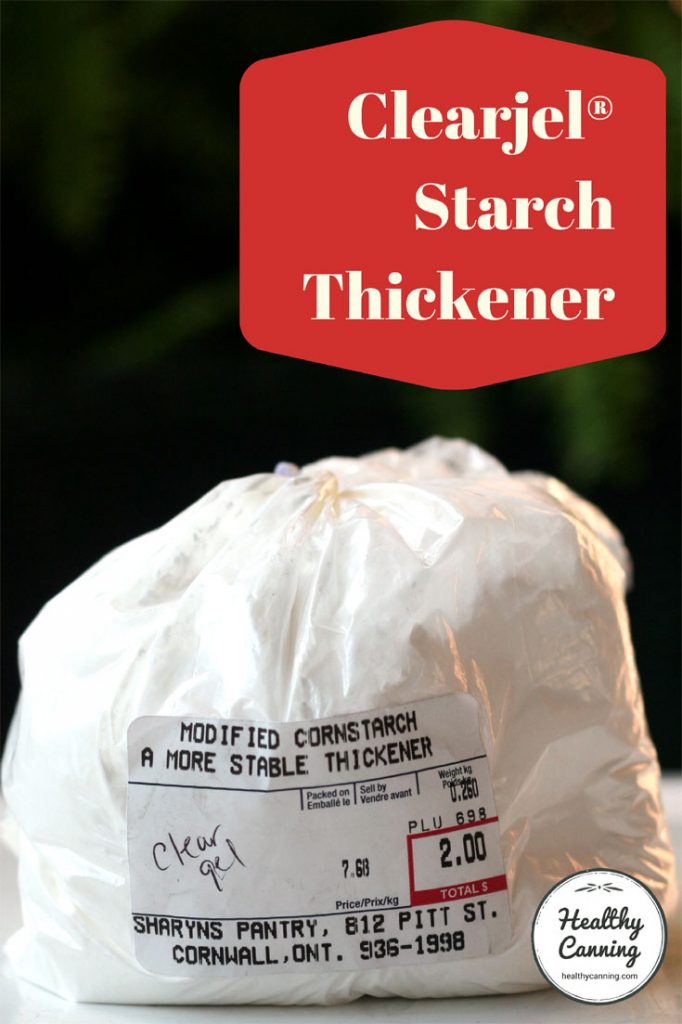
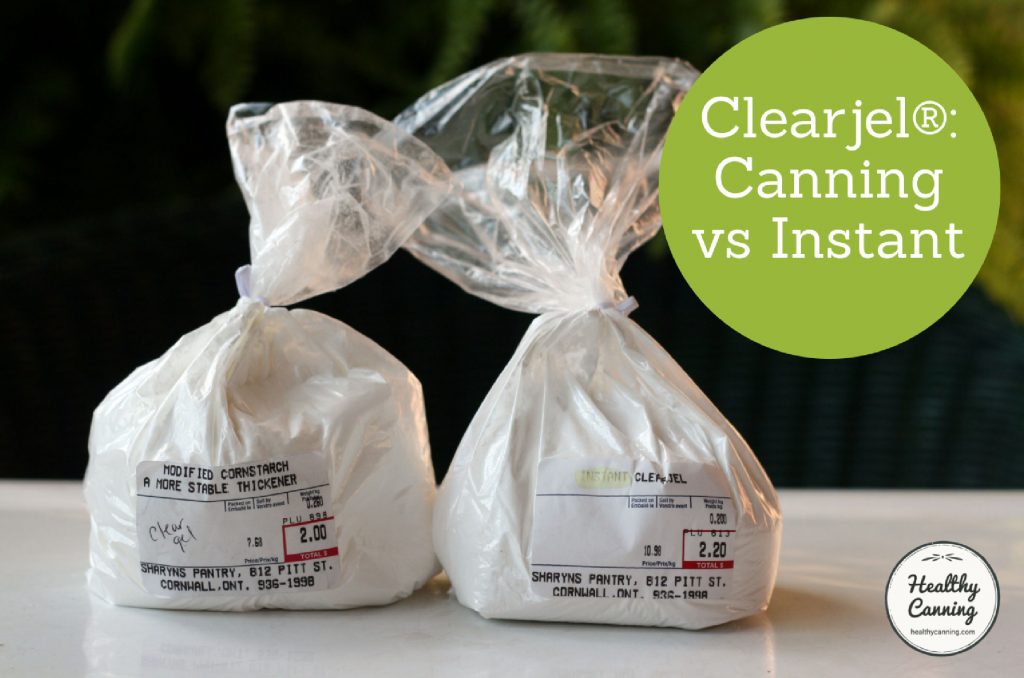
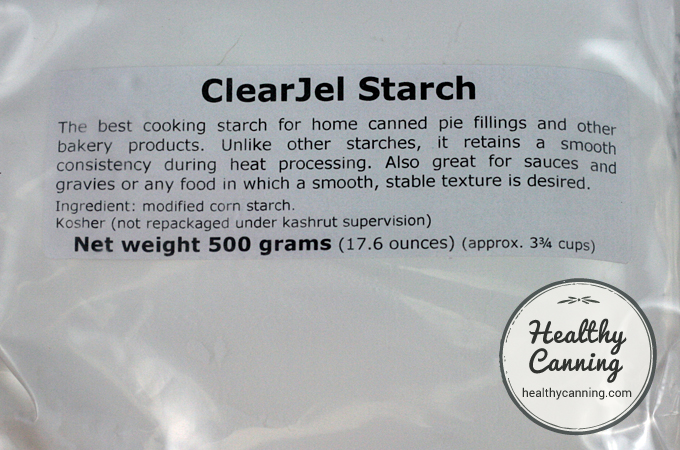
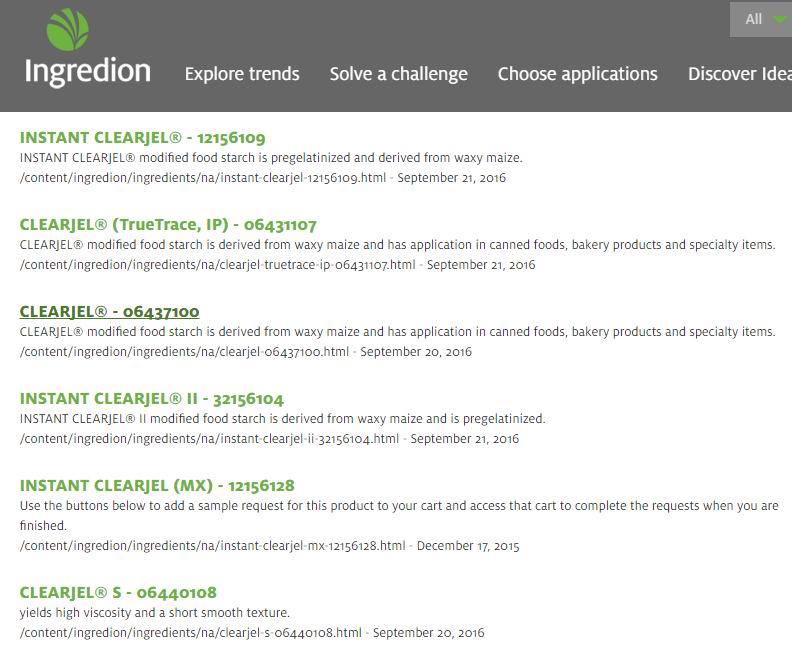
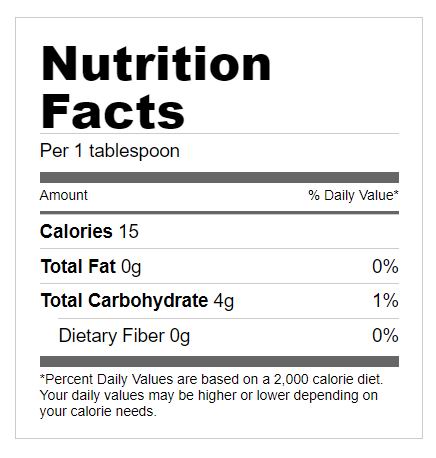
Anthony
Hi, pls help clarify? Can cooking clearjel be frozen when incorporating in dairy based fillings? Many sites have different facts. I know instant clearjel can be frozen but what about cooking clearjel? Appreciate your feedback. Thank you – Anthony
Michelle
Thank you, you really helped clear up my questions about Clear Jel. I feel better about using it now.
Menolly
I see more and more pressure canned recipes that are using cooking clearjel (not instant) to thicken fruit fillings, soups and stews, because it only thickens after you cook it, not instantly, thus not affecting the density. What’s your take on using cooking clearjel?
Healthy Canning
Clearjel has been research-tested in several home canning recipes, so it’s absolutely fine to use it in those. But that doesn’t mean it can be added willy-nilly to recipes for which its presence hasn’t been research-tested.
Mary Shaw
I have never seen Clearjel. I would like to know what it is and where it can be purchased,
Healthy Canning
You can get it online or at really good canning supply stores; some bulk stores may also carry it.
Wendy
Is it safe to completely omit clearjel from recipes that include it? I’d prefer to avoid using this highly processed ingredient if possible.
Healthy Canning
Yes, it is safe to omit. You are reducing the density. You can thicken with flour, tapioca, arrowroot, regular cornstarch, etc, upon opening.
Donette Bernot
Excellent read, I just passed this onto a friend who was doing some research on that. And he just bought me lunch since I found it for him smile Therefore let me rephrase that: Thank you for lunch!
vic hood
where can I purchase clearjel in Barrie Ontario
Healthy Canning
Your best bet might be to track down baking supplies stores.